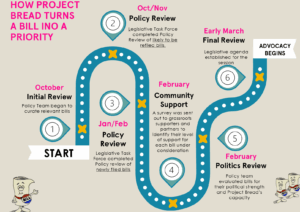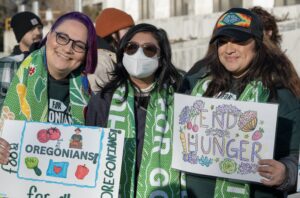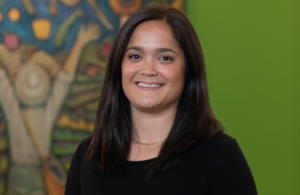With the White House Conference on Hunger, Nutrition and Health looming, food bankers have identified improved access to healthy food as a high-priority outcome, though they are only cautiously optimistic that this and other goals can be achieved.
The White House conference, scheduled for sometime in September, comes more than 50 years after the first such summit, which is credited with addressing severe hunger through the creation of WIC as well as major expansions of many of the food and nutrition programs we know today, including SNAP and the National School Lunch Program. These days, the front and center issues include the more complicated task of addressing the root, interconnected causes of hunger.
“There are so many buckets of hunger and they’re all so complex,” said Valerie Hawthorne, Director of Government Relations at North Texas Food Bank.
Extensive listening sessions organized throughout the food banking network have yielded a common thread of feedback from people with lived experience, food bankers say. “Number one would be access to healthy, nutritious food – more so than we have today,” said Paule Pachter, CEO of Long Island Cares.
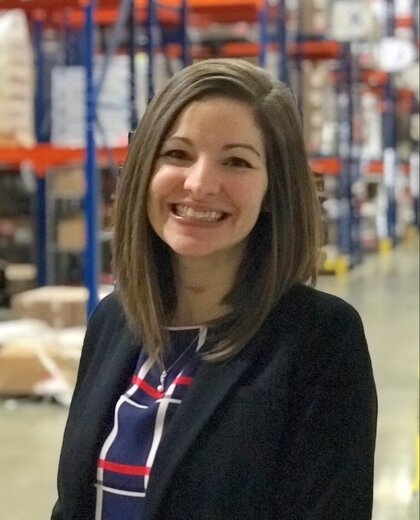
Similarly, when the Greater Cleveland Food Bank held community listening sessions with food-insecure individuals, “almost every single person shared that the best way to combat food insecurity in our community is to increase SNAP,” said Kimberly LoVano, Director of Advocacy and Public Education. “They want to eat healthier, but without increased SNAP benefits, it’s just not possible. Healthy food is just more expensive.”
Northwest Harvest also heard that message from participants in its listening exercise, said Christina Wong, Public Policy & Advocacy Director. While respondents want solutions that address the root causes of food insecurity, they also want strategies that have an immediate impact in terms of expanding the eligibility and adequacy of nutrition assistance and other assistance programs.
Potential improvements to SNAP include allowing it to be used for hot and prepared foods, as well as for vitamins and hygiene products, such as soap, shampoo, and diapers. “Things that we all use,” LoVano emphasized. SNAP should also better reflect the cost of living, food bankers say. “Making sure that benefits are adequate with the rising cost of inflation is really important,” LoVano said.
SNAP could also be modified to reflect regional cost differences. “We know that food is more expensive in some areas of the country, so having a national standard is pretty difficult to wrap your head around,” Hawthorne said. Pachter advocated for regionalizing the federal poverty level upon which SNAP eligibility is based. “To look at the federal poverty level and adjust it for the economics of each of the states and the cost of living seems to us to make more sense,” he said.
The discussions around SNAP also highlight a growing debate over whether SNAP purchasing should be restricted to more nutritious food. Doing so could guide consumers to more nutritious choices and help address the country’s epidemic of diet-related disease. But others fear that restrictions will turn SNAP into an unappealing program that fewer people will use.
“My biggest concern is that food insecurity kind of becomes one of a few different issues that are discussed, and I think it needs to be issue number one,” LoVano said. Hawthorne voiced a similar concern, saying, “All of the stakeholders have their own agendas, so whose voice is going to be the loudest? Nutritional security is very different from food scarcity.”
The distinction between food and nutrition insecurity is a matter of deep concern for Craig Gundersen, Snee Family Endowed Chair at the Baylor Collaborative on Hunger and Poverty. He believes it would be a mistake to limit the autonomy that SNAP allows participants in making food purchases. “SNAP is a successful program,” he said. If restrictions are imposed, “it will no longer be a successful program.”
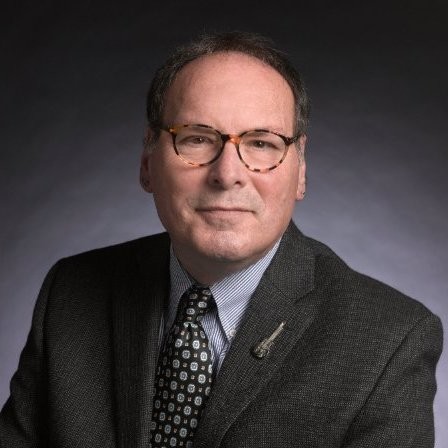
Despite the priority placed on improved food access, observers are well aware that food alone will not solve hunger. LoVano noted that over 90% of families used the American Rescue Plan’s expanded Child Tax Credit for food, utilities, rent, mortgage and education. “We need to see a lot more investments in employment, transportation, housing, etc., if we’re really serious about ending hunger,” she said.
While Wong hopes the Conference will yield policy interventions with immediate impact, she’s adamant that those interventions also target systemic racism baked into programs. “How often are we looking at the data to see if we are closing or growing racial disparities in the results, and then reviewing and making changes with the goal of closing those racial disparities?” she asked.
In addition to policy interventions, Hawthorne hopes that the Conference will produce “a better way to quantify hunger in the United States” through improvements in food security research. She added that it’s essential that the goal of ending hunger by 2030 be defined in a way that’s measurable and achievable.
Are people optimistic about the potential impact of the 2022 Conference? “I’m always an optimist; otherwise, I still wouldn’t be here,” Hawthorne said. Pachter, meanwhile, is hopeful. “I wouldn’t say I’m optimistic because we don’t know what Congress will look like in January 2023, but I’m hopeful that the Biden-Harris Administration won’t simply put this on a shelf to collect dust.”
Gundersen, however, struck a different tone. “I’m not optimistic,” he said, because of fears that restrictions to SNAP based on nutrition goals will limit its appeal and usage. His hope is that SNAP benefits will stay increased and that more people will have access to it. “That’s what I would love to see come out of this conference. But it’s not going to.” – Amanda Jaffe
Amanda Jaffe is a writer and former attorney with a deep interest in the organizations and mechanisms that address food insecurity. Her writing has appeared in The American Interest, PASSAGE Magazine, and the Finder, among other publications.
Like what you’re reading?
Support Food Bank News

